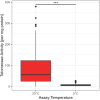Seasonal variation in telomerase activity and telomere dynamics in a hibernating rodent, the garden dormouse (Eliomys quercinus)
- PMID: 38074328
- PMCID: PMC10698472
- DOI: 10.3389/fphys.2023.1298505
Seasonal variation in telomerase activity and telomere dynamics in a hibernating rodent, the garden dormouse (Eliomys quercinus)
Abstract
Telomere dynamics in hibernating species are known to reflect seasonal changes in somatic maintenance. Throughout hibernation, the periodic states of rewarming, known as inter-bout euthermia or arousals, are associated with high metabolic costs including shortening of telomeres. In the active season, if high energetic resources are available, telomere length can be restored in preparation for the upcoming winter. The mechanism for telomere elongation has not been clearly demonstrated, although the action of the ribonucleoprotein complex, telomerase, has been implicated in many species. Here we tested for levels of telomerase activity in the garden dormouse (Eliomys quercinus) at different seasonal time points throughout the year and across ages from liver tissues of male juveniles to adults. We found that telomerase is active at high levels across seasons (during torpor and inter-bout euthermia, plus in the active season) but that there was a substantial decrease in activity in the month prior to hibernation. Telomerase levels were consistent across age groups and were independent of feeding regime and time of birth (early or late born). The changes in activity levels that we detected were broadly associated with changes in telomere lengths measured in the same tissues. We hypothesise that i) telomerase is the mechanism used by garden dormice for maintenance of telomeres and that ii) activity is kept at high levels throughout the year until pre-hibernation when resources are diverted to increasing fat reserves for overwintering. We found no evidence for a decrease in telomerase activity with age or a final increase in telomere length which has been detected in other hibernating rodents.
Keywords: biological ageing; euthermia; oxidative damage; somatic maintenance; torpor.
Copyright © 2023 Galindo-Lalana, Hoelzl, Zahn, Habold, Cornils, Giroud and Smith.
Conflict of interest statement
The authors declare that the research was conducted in the absence of any commercial or financial relationships that could be construed as a potential conflict of interest.
Figures



Similar articles
-
Food availability positively affects the survival and somatic maintenance of hibernating garden dormice (Eliomys quercinus).Front Zool. 2023 May 24;20(1):19. doi: 10.1186/s12983-023-00498-9. Front Zool. 2023. PMID: 37226260 Free PMC article.
-
Late-born intermittently fasted juvenile garden dormice use torpor to grow and fatten prior to hibernation: consequences for ageing processes.Proc Biol Sci. 2014 Dec 22;281(1797):20141131. doi: 10.1098/rspb.2014.1131. Proc Biol Sci. 2014. PMID: 25377448 Free PMC article.
-
An hourglass mechanism controls torpor bout length in hibernating garden dormice.J Exp Biol. 2021 Dec 1;224(23):jeb243456. doi: 10.1242/jeb.243456. Epub 2021 Dec 9. J Exp Biol. 2021. PMID: 34762135 Free PMC article.
-
Understanding seasonal telomere length dynamics in hibernating species.J Therm Biol. 2024 Jul;123:103913. doi: 10.1016/j.jtherbio.2024.103913. Epub 2024 Jul 5. J Therm Biol. 2024. PMID: 39002254 Review.
-
Regulation and Effect of Telomerase and Telomeric Length in Stem Cells.Curr Stem Cell Res Ther. 2021;16(7):809-823. doi: 10.2174/1574888X15666200422104423. Curr Stem Cell Res Ther. 2021. PMID: 32321410 Review.
Cited by
-
Food deprivation is associated with telomere elongation during hibernation in a primate.Biol Lett. 2025 Feb;21(2):20240531. doi: 10.1098/rsbl.2024.0531. Epub 2025 Feb 12. Biol Lett. 2025. PMID: 39933571
-
Unpredictable warm spells in winter increase blood cortisol level but lengthen telomeres in a seasonal rodent Phodopus sungorus.Proc Biol Sci. 2025 Jun;292(2049):20250819. doi: 10.1098/rspb.2025.0819. Epub 2025 Jun 18. Proc Biol Sci. 2025. PMID: 40527455 Free PMC article.
References
-
- Barton K. (2023). MuMIn: multi-model inference. R package version 1.47.5. Available at: https://CRAN.R-project.org/package=MuMIn.
Grants and funding
LinkOut - more resources
Full Text Sources

